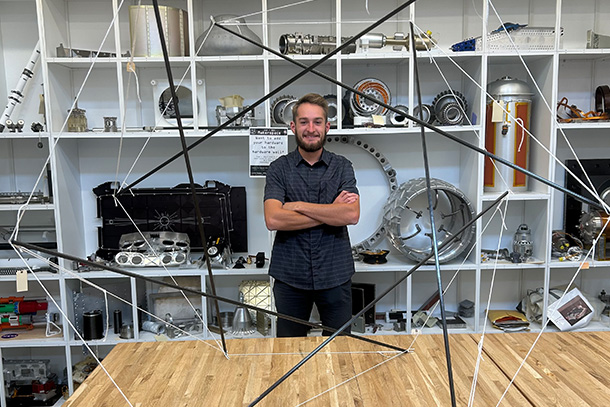
Nate Osikowicz, a Penn State doctoral student in aerospace engineering, has received a NASA Space Technology Graduate Research Opportunities award. Credit: Courtesy NASA/JPL-Caltech.
Aerospace graduate student receives NASA research opportunity
Nov 14, 2024
By Sarah Small
UNIVERSITY PARK, Pa. — Nate Osikowicz, a Penn State doctoral student in aerospace engineering, has received a NASA Space Technology Graduate Research Opportunities (NSTGRO) award. The award sponsors graduate students who have the potential to contribute to the development of innovative new space technologies.
“Nate is among the most talented and hardworking students with whom I have worked in my career,” said Puneet Singla, the Harry and Arlene Schell Professor of Engineering in the Department of Aerospace Engineering and Osikowicz’s adviser. “He is one of the rare students who can do equally well in three pillars of engineering: analytics, computations and experiments. I am looking forward to him receiving more accolades in the near future.”
As part of the NSTGRO mission to develop high-risk, high-reward early-stage technology, the recipients of the award will conduct research both at their respective campuses and at NASA centers through the agency’s visiting technologist experience.
Osikowicz’s research, which he will conduct with both Singla and NASA researchers including John Cooper at NASA Langley and Rudranarayan Mukherjee at NASA’s Jet Propulsion Laboratory, will focus on in-space assembled structures.
“One of the growing trends in space technology, such as satellites designed for remote sensing and communications needs, is the increasing size of reflector apertures,” Osikowicz said, referring to a component that focuses transmitted and received radar signals to continuously scan the surface of the Earth. “For example, the upcoming NASA-ISRO Synthetic Aperture Radar (NISAR) mission will be outfitted with a sizeable 12-meter-diameter reflector. NISAR will help scientists better understand Earth processes such as changes in ice sheets, forest ecosystems, and soil moisture.”
While the increased size of the reflectors improves NASA’s remote sensing capability, the overall size of deployable space structures is limited by the mass and volume constraints of the launch vehicles. According to Osikowicz, this makes in-space assembly possibly the only solution for reflectors with a diameter larger than 15 meters.
The key with in-space assembly, he said, will be to minimize mass while making sure the assembled reflector is robust and adaptable.
“We are trying to answer the question, ‘How can we build minimum-mass structural modules that maintain integrity and adaptability throughout the assembly process?’” Osikowicz said.
To meet these needs, Osikowicz’s research investigates tendon-actuated structural modules. The research is based on his prior investigations of the tensegrity paradigm, a minimum-mass structural principle.
Previously, Osikowicz received a National Science Foundation Graduate Research Fellowship. He said that the work he conducted with the fellowship included collaborations with NASA and helped lay the groundwork for future collaborations, such as the work that will be conducted with the NSTGRO.
“With the support of the NSTGRO award, I can build a relationship with subject matter experts to make the technology as relevant as possible,” Osikowicz said. “The fellowship also provides support for building my own prototypes, which I’m really excited about because I come from a family of tradespeople. It’s very important to me to honor their tradition while using my engineering degree to advance the current state of the art.”

